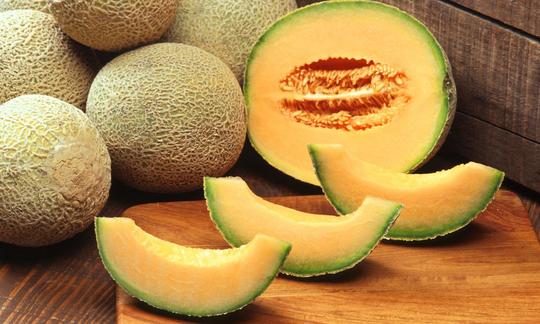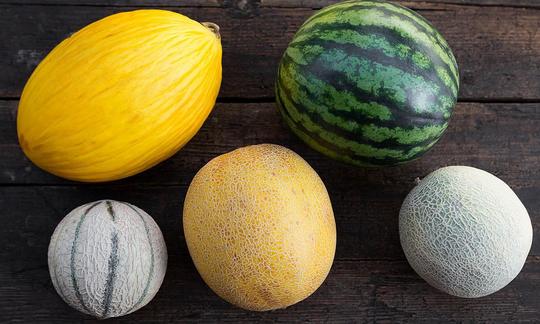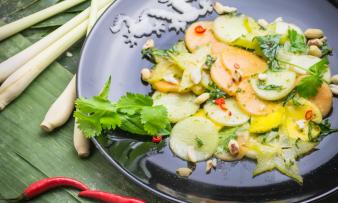Table of contents
Use in the kitchen
Cantaloupe melons ( Cucumis melo var. cantalupensis or var. reticulatus ) have orange flesh that is very sweet and juicy. This is why sugar melons such as the cantaloupe melon or the honeydew melon are popular as dessert melons or raw finger food.
Fresh cantaloupe melon pieces taste good raw in muesli, fruit salad or punch. Some people compare their taste to a papaya . Fruits such as pear, nectarine, peach, apple, orange etc. harmonize perfectly with this sugary sweet melon, a little lemon juice adds a good acidity. If you halve the melon and hollow it out, you can use it as a serving bowl placed on ice cubes.
The flesh of a cantaloupe melon, freshly juiced, perhaps with an apple or a mango, makes a good thirst quencher. Boiled melon juice, i.e. syrup, is good for sweetening and refining vegan creams. Cantaloupe melons can also be used to make delicious vegan sorbets, cocktails, smoothies and raw shakes. Vegan melon lassi can be prepared with vegan yoghurt ( soy yoghurt ) and a plant-based drink (e.g. oat milk ).
The intense sweetness of the cantaloupe melon gives spicy salads an exotic touch. With cucumbers, tomatoes, red onions and avocado - combined with fresh herbs such as mint, coriander and basil - you can prepare a refreshing dish in no time. If you mix the sweet melon with ingredients such as bulgur, rice noodles or baked sweet potatoes and season with a little chili, you get richer vegan salads. A gazpacho (cold, spicy soup) made from cantaloupe melons is an excellent melon recipe for hot days.
Vegan recipe for cantaloupe melon salad
Ingredients (for 4 people): 1 cantaloupe melon (e.g. Charentais melon, raw, organic), 500 g cherry tomatoes, 1 jar of cooked chickpeas (approx. 240 g drained weight), 2 tbsp Aceto Balsamico Bianco ( balsamic vinegar, white ), 2 tbsp rapeseed oil, salt, pepper, approx. 30 g basil.
Preparation: Halve the melon, remove the seeds and cut into balls or cut into bite-sized pieces. Halve the cherry tomatoes. Rinse the chickpeas from the jar and drain. Put the melon pieces or melon balls in a bowl with the cherry tomatoes and chickpeas and season with vinegar, oil, salt and pepper. Cut the basil leaves into fine strips and mix into the vegan salad.
For more recipes with cantaloupe melons, see the note: " Recipes that make the most of this ingredient ".
| Not only vegans or vegetarians should read this: Vegans often eat unhealthily. Avoidable nutritional mistakes . |
Purchasing - Storage
Cantaloupe melons can be found in the large supermarket chains such as Coop, Migros, Denner, Volg, Spar, Aldi, Lidl, Rewe, Billa, Edeka or Hofer, often in controlled organic quality (organic quality). This variety can often be bought in organic supermarkets such as Denn's Biomarkt or Alnatura, as well as seasonally at the weekly market.
Cantaloupe melons are available in Central Europe from May to August (depending on the size of the supermarket and region, from March or until September), while regional products have their peak season between July and September . 27
You can recognize a ripe cantaloupe melon by its intense, sweet, aromatic smell, which you can also smell through the skin (especially at the base of the stem). 2 Overripe fruits smell unpleasantly intense, slightly fermented. When buying, make sure the skin is intact.
Cantaloupe melons vary in shape and appearance. The skin can be smooth, warty, scarred like a net and/or have green stripes (furrows). 18,19 Depending on the variety, the flesh is white-greenish, dark yellow, but usually bright orange. 19 The variants 'Charentais' and 'HaOgen' 15,21 are considered cantaloupe melons; a Cavaillon melon (from Cavaillon in France) is very often a Charentais melon.
The availability of cantaloupe melons varies depending on the size of the store, catchment area, etc. If you are interested, click on our recorded food prices for the DA-CH countries above under the ingredient image - and click to see their development at different suppliers.
Storage tips
Ripe, whole cantaloupe melons cannot be stored for very long at room temperature. Even refrigerated (3-5 °C) they can be kept for a maximum of 3 weeks. It is worth allowing (whole) cantaloupe melons to ripen a little at room temperature, provided they are not overripe. Cut melons should be stored in the refrigerator and eaten within a few days, as they spoil quickly. 2
The flesh of melons is low in acid and provides a good breeding ground for harmful microorganisms such as salmonella, listeria or EHEC. The pathogens get onto the flesh either when the (unwashed) peel is cut open or via contaminated hands or kitchen utensils (knife, cutting board). To prevent infections, good kitchen hygiene is very important and pre-cut melon pieces should be eaten quickly or refrigerated. If stored unrefrigerated for several hours, the Federal Institute for Risk Assessment ( BfR ) recommends that the melons be disposed of. 3
Ingredients - Nutritional values - Calories
Raw cantaloupe melons (organic) have 34 kcal per 100 g and are therefore one of the lowest-calorie cantaloupes. Cantaloupe melons contain a lot of juicy pulp, which consists of 90% water . The carbohydrate content of 8.2 g/100g is rather low.
Does the cantaloupe melon contain fructose? Cantaloupe melons also contain fructose. With a sugar content of around 7.9 g/100g, the fructose content is around 1.9 g/100g, the rest is mainly sucrose and glucose. In comparison, the Galia melon, for example, contains slightly more fructose (fructose content: around 2.4 g/100g 22 ).
With 0.19 g fat and 0.84 g protein per 100 g, the cantaloupe melon is almost fat-free and very low in protein. The 0.9 g fiber covers 3.6% of the daily requirement. 4
A raw cantaloupe melon has 37 mg of vitamin C per 100 g, which is 46% of the daily requirement. Mangos (36 mg/100g) andblack elderberries (36 mg/100g) have comparable amounts. The vitamin C content in sea buckthorn berries is extremely high at 450 mg/100g. 4
The vitamin A content, as RAE, is 169 µg/100g (21% of the daily requirement) and is comparable to that of red bell peppers (157 µg/100g) and aronia berries (192 µg/100g). Raw carrots have a high vitamin A content of 835 µg/100g. 4
Cantaloupe melon contains 267 mg/100g of potassium (13% of the daily requirement). Red and white currants (275 mg/100g) and zucchini (261 mg/100g) have a similar amount of potassium. One fruit with a lot of potassium is raw jackfruit (448 mg/100g). 4
The complete ingredients of cantaloupe melons, the coverage of the daily requirement and comparison values with other ingredients can be found in our nutrient tables. In the article Nutrients explained you will get a detailed insight into the topic.
Health Benefits
Cantaloupe juice has an alkalizing effect on urine, which promotes the dissolution and excretion of urinary stones. Melon juice can therefore serve as an alternative preventive measure to potassium citrate medications. 7 This alkalizing effect on urine can help prevent urinary tract diseases. 8
Cantaloupe melons have a medium glycemic index (65) and a low glycemic load (4.7). Therefore, when consumed in moderate amounts, they are also suitable for diabetics (for explanations, see the ingredient watermelon ). 20
Secondary plant substances
Many of the health benefits of cantaloupe melons can be attributed to the secondary plant substances they contain. Our article on secondary plant substances provides an overview of the classification of substance groups, their occurrence in foods and possible effects on humans.
Since the name "cantaloupe melon" is often not used consistently, it can refer to melon varieties that look different (see the "Further information" chapter). The general term "sugar melons" or the species name Cucumis melo are often used synonymously for individual melon varieties. Therefore, in addition to the secondary plant substances of the "cantaloupe melon" variety, we also describe those of the supergroup "sugar melons".
Cantaloupe melons contain the following secondary plant substances: 6, 29,30,31
- Isoprenoids : Terpenes: Triterpenes (curcurbitacin); Carotenoids: beta-carotene, lutein, zeaxanthin; Saponins
- Alkaloids
- Polyphenols : Phenolic acids: caffeic acid, sinapic acid, rosmarinic acid, ferulic acid, gallic acid, ellagic acid, quinic acid; Flavonoids: Flavonols (rutin, kaempferol, quercetin, isorhamnetin, myricetin), flavanones (naringenin, eriodictyol, eriocitrin, naringin, pinocembrin), flavones (isovitexin, apigenin, luteolin, acacetin), chalcones (phlorizin); Phytoestrogens: Formononetin; among others.
However, it should be noted that the composition of secondary plant substances in cantaloupe melons can vary depending on the variety, time of harvest and growing conditions. Therefore, quantities are only of limited use and should only be understood roughly.
Research on the phytochemicals in muskmelon shows that Cucumis melo is a source of natural antioxidants and can therefore serve as a potential therapeutic agent for the prevention of oxidative stress and related diseases. This effect may be due to the synergistic effect of the diverse phytochemicals in muskmelon. 31
An in vivo animal study found that muskmelons have anti-inflammatory properties. In the study, rats suffering from inflammatory swelling were treated with ethanol extracts from nettle melons and cantaloupe melons. A reduction in inflammation was observed within a few hours of treatment. The researchers involved attribute this anti-inflammatory effect to the 44 identified polyphenols and isoprenoids in the melon samples examined. 30 Carotenoids such as beta-carotene, lutein and zeaxanthin also show antioxidant and anti-inflammatory properties in relation to eye health in animal models. They help prevent phototoxic damage to eye tissue by absorbing blue light, among other things. 5 In addition to cantaloupe melons, these carotenoids are also found in other yellow-orange fruits and green vegetables. 6
An animal study in China found that the cucurbitacins in Cucumis melo also have antihypertensive properties. The study, which investigated the effectiveness of clinical drugs for treating high blood pressure, was able to demonstrate that curcubitacins work by improving blood vessel tension. 29
An in vitro study was able to show that in addition to the pulp, the seeds of the sugar melon also contain bioactive substances. It was also found that these substances can inhibit the growth of various types of cancer cells. The scientists involved attribute this effect to the polyphenols contained in the product, in particular the high concentration of gallic acid and rutin. Polyphenols act as scavengers of free radicals in cells and studies have already shown effects against various ailments such as neuronal diseases, cardiovascular diseases, cataracts and cancer. However, additional studies are required to identify other secondary plant substances from sugar melons and to research their effect against cancer in more detail. 32
The bioactive plant compounds in Cucumis melo also have positive effects on the gastrointestinal tract and can prevent insulin resistance and diabetes. In an animal study, it was found that eating cantaloupe can inhibit inflammation in the intestines and thus improve existing insulin resistance. In addition , Cucumis melo promotes a healthier intestinal bacterial composition and improved glycemic control. 23 In addition, scientific studies show that the phytonutrients contained in cantaloupe can improve blood sugar metabolism and insulin metabolism. In studies on diabetic animals, extracts from cantaloupe melons reduced oxidative stress in the kidneys and helped to counteract insulin resistance. 20
Dangers - Intolerances - Side effects
Sugar melons ( Cucumis melo ) can trigger allergic symptoms. In Spain, an allergy to melons is the second most common fruit allergy. Connections with other allergy triggers are striking, such as pollen from trees and grasses, fruit (peach) and latex. 9
Even though the fructose content of cantaloupe melons is rather low, people with fructose intolerance or fructose intolerance should be careful.
Folk medicine - natural medicine
Sugar melons such as cantaloupe or honeydew melon have hydrating, remineralising, alkalising, diuretic and laxative effects. 8
Ecological footprint - animal welfare
Cantaloupe melons come from European countries such as Spain and Italy during the peak summer season. Thanks to shorter transport routes and lower CO 2 emissions, this results in a smaller ecological footprint than products imported from other continents. However, countries such as Spain are always struggling with water shortages, which is why the high water consumption of melon plants (approx. 200 liters per kilogram of melon) 14 is often criticized. 24 Melons in Spain often grow in huge greenhouses, where they receive enough moisture through pot irrigation. Irrigating the plants with wastewater could be an ecological alternative in the future. 26 In organic farming, no chemical-synthetic pesticides or fertilizers are used because they pollute the groundwater. Organic melons should therefore be preferred to those from conventional farming . 14
Animal welfare - species protection
The pesticides used in conventional agriculture harm honey bees, the most important pollinators of melon plants. The bees are exposed to these pesticides through direct physical contact or by collecting pollen and, if the exposure is too high, they show physical impairments or weakened immune reactions. 25
Worldwide occurrence - cultivation
Melons of the species Cucumis melo originally come from Asia and not from East Africa, as was long assumed. 10,17 The authors of a scientific article from 2012 put forward the hypothesis that the Romans were familiar with ripe round melons (of the species Cucumis melo ), but not yet as very sweet varieties (sugar melons). This is supported by the much more frequent mention of the so-called 'snake melons' (Armenian cucumbers) and the Adzhur melons in ancient literature, which were harvested and eaten when unripe; both have a cucumber-like taste and are not sweet even when fully ripe. Sweet melons of the Cantalupensis group reached Italy from Armenia towards the end of the 15th century and then spread to neighboring countries and large parts of Europe. 17
Today, the sugar melon, which has numerous regional varieties and types, is grown worldwide in the tropics and subtropics as well as in the Mediterranean region. The main growing areas for sugar melons in Europe are Spain, Italy and France (2019). 11
A small proportion of sugar melons are also grown in Switzerland: cantaloupe melons (Charentais variant), honeydew melons and netted melons such as Galia melons (for the classification of cantaloupe and netted melons, see the chapter on further information). In 2020, around 4 tonnes of melons were produced in Switzerland. In contrast, 28,290 tonnes of sugar melons and 40,100 tonnes of watermelons were imported in the same year. 12
Found in the wild
Cultivated cantaloupe melons cannot be found in the wild. However, wild varieties of the species Cucumis melo do exist. Such wild forms occur in the following countries/regions: Africa, Asia, the Pacific region and Australia. 1 A well-known example is the Australian wild cucumber ( Cucumis melo ssp. agrestis ) with its 4-5 cm long, thick fruits. Its skin tastes bitter, the flesh slightly sweet and similar to cucumber; therefore it is usually eaten cooked.
Cultivation - Harvest
Can you grow a cantaloupe melon? It is certainly possible to grow a cantaloupe melon yourself. In addition to a warm environment and sufficient water, the right location and good soil conditions are also important. Loose, permeable, slightly sandy soil is important to avoid waterlogging. Nutrient-rich soils enriched with compost or rotted manure help to produce good yields. The pH value can be on the acidic side at 5.5-7. To ensure more constant temperatures, a black film over the ground (also reduces the growth of weeds) or growing in a foil tunnel (wind protection) are ideal for melons. Regular watering (in the evening in summer), fertilizing and weeding contribute to the good development of the fruit. It is also recommended to start the young plants early. The seeds are best bought in stores, as many melons are hybrids and their seeds do not germinate. At the beginning of April, the seeds are grown indoors and from May onwards the young plants are planted in the greenhouse or in a pot on the balcony or terrace. The Charentais variety can also grow hanging in the air because of its small fruits (0.7-0.9 kg depending on the variety) and is therefore also called 'balcony melon'. In the pot, daily watering is very important so that the plant always has enough water. The fruits are ready to harvest towards the end of August. 13 This can be seen when the green leaves turn yellow, the stem breaks off easily and the skin turns yellow. Cantaloupe melons also have an aromatic scent that indicates their degree of ripeness. 2
Further information
Are melons fruits or vegetables? Melons belong to the gourd family (Cucurbitaceae) and are therefore classified as fruit vegetables. They are annual plants that form climbing shoots that can be up to several meters long.
Melons are generally divided into watermelons (species: Citrullus lanatus ) and sugar melons (species: Cucumis melo L.). Sugar melons are botanically more closely related to the cucumber ( Cucumis ) than to the watermelon.
The further classification of sugar melons is controversial due to numerous crosses and name confusions. 19,21 In Europe, the following varieties (not melon species) are mainly distinguished: cantaloupe melon ( Cucumis melo var. cantalupensis or cantaloupensis ), honeydew melon ( Cucumis melo var. inodorus ) and netted melon ( Cucumis melo var. reticulatus , the Latin adjective reticulatus means: provided with a net / net-like). 17
However, the cantaloupe melon grown in North America is a netted melon ( Cucumis melo var. reticulatus ) 20 and is strictly speaking considered a "fake" representative of the name. 19 This increases the confusion. For this and other reasons, there are suggestions to group the varieties cantalupensis and reticulatus together. 19 There is also disagreement about the classification of the Galia melon, a hybrid; 20,21 however, it is largely classified as a netted melon.
A popular variant of the cantaloupe melon is the Charentais melon ( Cucumis melo var. cantalupensis 'Alienor'), which is mainly grown in France. The skin of the Charentais melon is white to yellowish or light green, usually with dark green longitudinal stripes, smooth, warty or netted. The flesh is orange and tastes even sweeter than that of the cantaloupe melon. The 'HaOgen' variety is known for its small, round, yellowish-green, smooth-skinned or ribbed melons. The Cucumis melo var. cantalupensis 'HaOgen' has a whitish to pale green flesh. 15
The sugar melon, known as dessert melon, tastes sweet. But there are also many sugar melons that do not taste sweet and are used in a similar way to cucumbers.
The melon name Cantaloupe comes from the Italian town of Cantalupo (in Sabina, near Rome), where the melon was first cultivated in Europe from seeds imported from Armenia. 16 The name 'Melon de Cavaillon' (Cavaillon melon) is a designation of origin for melons from the region around Cavaillon in France (mostly Charentais melons).
Alternative names
In German, the melon called Cantaloupe is also called Warzenmelone. In addition to the spellings of melon with a C - such as Cantaloupe and Cantaloup - you can also find Kantalupe. Terms such as Cantaloupe Melone, Cantaloup Melone, Melone Cantaloupe, Melonen Cantaloupe or Melonenarten Cantaloupe (Melon species) are misspelled.
Common Latin synonyms for Cucumis melo var. cantalupensis are: Cm var. cantaloupensis, Cm var. cantalupo.
In English, the cantaloupe melon is known as cantaloupe (cantaloupe melon), rockmelon, sweet melon or spanspek (in South Africa), also common are: (cantaloupe) muskmelon, nutmeg melon.
Bibliography - 31 Sources
| 1. | Kerje T, Grum M. The origin of melon, Cucumis melo: a review of the literature. Acta Hortic. 2000;510:37–44. |
| 2. | Plantura.garden.de Cantaloupe-Melone: Alles zum Pflanzen & Pflegen der Zuckermelone. |
| 3. | BfR Bundesinstitut für Risikobewertung. Melonen können krankmachende Keime übertragen. 22/2013. |
| 4. | USDA United States Department of Agriculture. |
| 5. | Carpentier S, Knaus M, Suh M. Associations between lutein, zeaxanthin, and age-related macular degeneration: an overview. Crit Rev Food Sci Nutr. April 2009;49(4):313–326. |
| 6. | Abdel-Aal E-SM, Akhtar H, Zaheer K, Ali R. Dietary sources of lutein and zeaxanthin carotenoids and their role in eye health. Nutrients. 2013;5(4):1169–1185. |
| 7. | Baia L da C, Baxmann AC et al. Noncitrus alkaline fruit: a dietary alternative for the treatment of hypocitraturic stone formers. J Endourol. 2012;26(9):1221–1226. |
| 8. | Pamplona Roger JD, Heilkräfte der Natur. Ein Praxisbuch. Zürich 2006. 240-241. |
| 9. | Figueredo E, Cuesta-Herranz J et al. Clinical characteristics of melon (Cucumis melo) allergy. Ann Allergy Asthma Immunol. 2003;91(3):303–308. |
| 10. | Manchali S et al. Muskmelon. In: Jaiswal AK (Ed.). Nutritional Composition and Antioxidant Properties of Fruits and Vegetables, 2020, 533-546. |
| 11. | FAOSTAT Food and Agriculture Organization of the United Nations. Melons, other (inc. cantaloupes) 2019. |
| 12. | LID Landwirtschaftlicher Informationsdienst. Süsse Exotin - die Schweizer Melone. 2021. |
| 13. | Gartenjournal net: Der Anbau der Charentais Melone im eigenen Garten. |
| 14. | Umweltberatung at: Melonen - Wasser auf Reisen. |
| 15. | Pflanzen-lexikon com: Zuckermelonen (Cucumis melo). |
| 16. | Lexico com: Oxford English Dictionary. Cantaloupe. |
| 17. | Paris HS, Amar Z, Lev E. Medieval emergence of sweet melons, Cucumis melo (Cucurbitaceae). Ann Bot. 2012;110(1):23–33. |
| 18. | Bzfe Bundeszentrum für Ernährung. Melonenvielfalt XXL. Erfrischend und kalorienarm. 2019. |
| 19. | Perkins‐Veazie P, Beaulieu JC, Siddiq M. Watermelon, cantaloupe and honeydew. In: Siddiq M, ed. Tropical and Subtropical Fruits. 1st ed. Wiley; 2012:549-568. |
| 20. | Mariod AA, Saeed Mirghani ME, Hussein I. Cucumis melo var. cantalupo Cantaloupe. Unconventional Oilseeds and Oil Sources. 2017:107–111. |
| 21. | Nuñez-Palenius HG. Transformation of 'Galia' Melon to improve fruit quality. Dissertation. University of Florida. 2005. |
| 22. | Silveira AC, Aguayo E, Artés F. The suitability of three Galia melon cultivars and different types of cuts for the fresh-cut industry. Journal of the Science of Food and Agriculture. 2013;93(15): 3826–3831. |
| 23. | Lee D, Yoo JH, Lee BC. Therapeutic effect of Cucumis melo L. Extract on insulin resistance and the gut microbiome in lep ob /lep ob mice. Evidence-Based Complementary and Alternative Medicine. 2018;2018:1–10. |
| 24. | Zhiyenbek A, Beretta C, Stoessel F, Hellweg S. Ökobilanzierung Früchte- und Gemüseproduktion eine Entscheidungsunterstützung für ökologisches Einkaufen. ETH Zurich. 2016. |
| 25. | Pacifico dSI, Oliveira FAS et al. Pesticide exposure of honeybees (Apis mellifera) pollinating melon crops. Apidologie. 2015;46:703-715. |
| 26. | Segura ML, Moreno R et al. Effects of wastewater irrigation on melon "growing" under greenhouse conditions. Acta Hortic. 2001(559);345-352. |
| 27. | Lebensmittellexikon. Saisonkalender Obst- und Importkalender. 2023. |
| 29. | Yuan R-Q, Qian L u.a. Cucurbitacins extracted from Cucumis melo L. (Cuec) exert a hypotensive effect via regulating vascular tone. Hypertens Res. August 2019;42(8): 1152–1161. |
| 30. | Ezzat SM, Raslan M, Salama MM, Menze ET, El Hawary SS. In vivo anti-inflammatory activity and UPLC-MS/MS profiling of the peels and pulps of Cucumis melo var. cantalupensis and Cucumis melo var. reticulatus. Journal of Ethnopharmacology. Juni 2019;237:245–254. |
| 31. | Rajasree RS, Ittiyavirah SP et al. An evaluation of the antioxidant activity of a methanolic extract of Cucumis melo L. Fruit (F1 hybrid). Separations. 2021;8(8):123. |
| 32. | Zhang X, Bai Y, Wang Y, Wang C, Fu J, Gao L, et al. Anticancer properties of different solvent extracts of Cucumis melo L. Seeds and whole fruit and their metabolite profiling using hplc and gc-ms. BioMed Research International. 2020:1–9. |











Comments